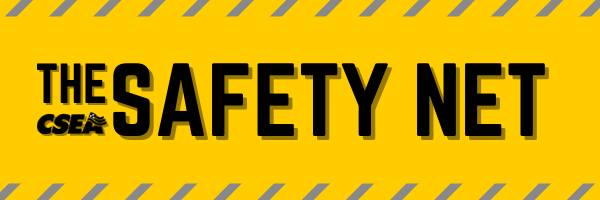
Tick-Borne Diseases & Monkeypox: June 2022
ANNOUNCEMENTS
WELCOME NEW SUBSCRIBERS!
Welcome to the Safety Net, CSEA’s official safety and health network! We hope you find our monthly newsletter fun, engaging, and informative. Our goal is to gain visibility and inspire safety activism in all work settings. Readers truly resonate with your shared stories, questions, and concerns. Featuring member-submitted content can inspire others to forge new connections and take action. We encourage your participation and appreciate having the opportunity to acknowledge our diverse membership.
Help rebuild our Safety Net!
Download/print in bulletin format to post in your workplace: cseany.org/safetynet
What’s New: Safety Net Newsletter
Featuring the Safety Net’s NEW advice column, “Dear Bernie!”
Write to “Dear Bernie” expressing your questions/concerns relating to workplace safety and health and receive advice from our OSH professionals!
Submissions can be emailed to Bernadette.foley@cseainc.org and will be published anonymously in the following edition. *All participants receive a complimentary prize for submitting their content.*
Monthly Subscriber Prize Drawing
July winners have been drawn! To claim your prize, you must respond to the confirmation email by the end of the month.
OSH Training: Civilian Response to Active Shooter Events (CRASE)
Mass shooting are increasing every year in the United States. In 2020, there were 611 mass shootings, 692 mass shootings in 2021 and so far in 2022, there have been 277 mass shootings, as this edition was published. May, June, and July are typically the months with the highest rates of mass shootings. (Gun Violence Archive)
This training course rooted in the run, hide, fight method will go into further depth on ways civilians and workers can protect themselves and others and respond correctly in the event they are in an active shooter situation. This workshop will include emotional testimonies and case studies from victims of previous active shooter tragedies.
Watch and share this important webinar 24/7 at your convenience: https://attendee.gotowebinar.com/register/8666650139324401936
TICK BORNE DISEASES
Everyone knows that ticks have the potential to carry diseases that can be passed onto their hosts, including humans. Many people are familiar with common diseases ticks can carry, including Lyme Disease and Rocky Mountain Spotted Fever. Very few people are aware that ticks can carry 16 diseases that they can pass on to human hosts. Of those diseases, nine are known to occur in the Northeastern U.S., according to the tick-borne disease webpage.
While contracting tick-borne diseases can have serious outcomes, as is the case for Lyme and Tularemia, if discovered early, they can be effectively treated to prevent serious and long-term health effects. Disease transmission often occurs when the tick expels digested blood back into the host, which can often take several hours to occur, so if the tick is removed before this occurs, the potential for disease transmission is minimized. Disease transmission normally takes between 36 to 48 hours after attachment.
The best prevention is to take precautions to prevent tick bites. These precautions are most important when ticks are the most active during warmer weather. Precautions to take include:
- Stay out of areas where there is leaf litter, brush and long grasses were ticks wait for passing hosts.
- Minimize exposed skin by wearing long clothing, tucking pant legs into socks and wearing light colors to make ticks easier to see.
- Use repellents to ward off ticks, some of which can be applied to the skin and others that are applied to clothing. Be sure to use them according to the instructions.
- After being in an area where ticks may be present, do a body search and remove any ticks that have become attached.
- If you have to remove any ticks, immediately contact your personal physician for directions on needed treatment.
MONKEYPOX
What you need to know:
- Monkeypox is rare and does not spread easily between people without close contact.
- Anyone can get and spread monkeypox.
- The threat of monkeypox to the general U.S. population remains LOW.
- Cases in the U.S. are still rare, as of June 13, there were only 64 cases in the U.S.
Symptoms are similar to, but milder than, smallpox:
- Begins with fever, headache, muscle aches, and exhaustion, about 7−14 days after being infected.
- Usually within 1 to 3 days of a fever, a rash will appear, often found on the face.
Monkeypox spreads between people primarily through direct contact with infectious sores, scabs, or body fluids; touching infected bedding, clothing, towels or objects and prolonged face-to-face contact. Practice good hand hygiene to help prevent spread of disease.
MEMBER SPOTLIGHT
Share your story, meme, or photo for chance to be featured in the Safety Net Newsletter!
Submissions can be emailed to bernadette.foley@cseainc.org. *All participants will receive a prize for submitting their content.*
MEMBER RESOURCES
To view/download our A-Z list of fact sheets and other materials, visit: cseany.org/safety-resources
For more information on trainings and educational resources, visit cseany.org/member-resources
CSEA Occupational Safety & Health (OSH) Specialists
To contact your OSH Specialist, visit cseany.org/member-support
CSEA OSH Specialists can provide training, technical assistance, labor-management services, and even help you establish a safety and health committee in your workplace.
Clean Up Safety Mobile App
The app is full of great information for anyone engaged in any sanitation or cleanup operations. The information can also help you at home to help keep you and your family safe!
Find more info/download at cseany.org/clean-up-safety
CSEA’s Occupational Safety & Health Activist’s Guide to Safety in the Workplace
View/Download by visiting cseany.org/safety or contact us to order print copies.

